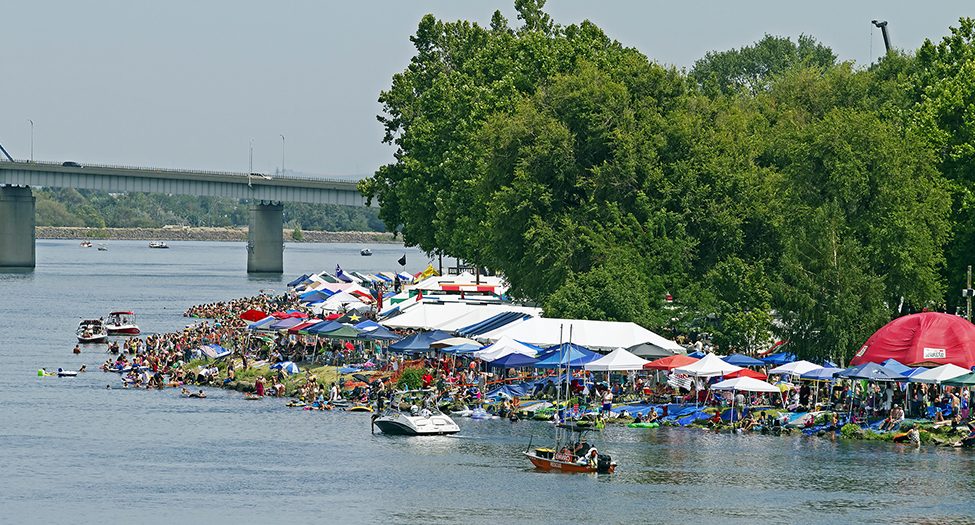
Home » Sports tourism a score for economy
Sports tourism a score for economy

July 15, 2019
Sports continues to be
big business in the Tri-Cities.
Visit Tri-Cities, the Tri-City area’s visitors and convention bureau, reports that last year there were 212 sports, convention and group activities that attracted 127,931 visitors who spent $38,157,557.
The same report
estimates that in 2019 and beyond there will be 227 sports, convention and
group activities that will attract 143,929 people who will spend $48,895,758,
or 28 percent more in spending.
“Sports tourism
provides significant economic impact for our community,” said Michael
Novakovich, president and chief executive officer of Visit Tri-Cities. “Last
year, sports and conventions sales generated over $38 million in visitor
spending. More than 42 percent of this economic impact is attributable to
overnight visitation of athletes and their families attending and participating
in sporting events.”
The benefit to the
community is multifaceted, Novakovich said.
“When athletes and
their families visit the Tri-Cities for sporting events, they spend a
considerable amount of money as they stay in our hotels, eat in our
restaurants, take in our attractions, buy from our retail, pump gas and
purchase groceries,” he said. “These are imported dollars — dollars that didn’t
exist in our community until these visitors arrived.”
Novakovich added that
visitor spending in the region supports more than 6,300 jobs.
Twenty-five years ago,
the numbers were nowhere near what they are now.
But something happened
back then to help: a community-led sports council was created.
Starting a sports council
Even back in the 1990s,
community leaders knew sports was big business.
So Don Hart and a group of like-minded citizens created the Tri-Cities Sports Council in 1996.
“In 1996, the
Tri-Cities was going through some harrowing economic times because the DOE had
cut a number of key programs in the area over the previous years …,” Hart said.
“There were a number of task forces underway to look at possibilities and new
ideas.”
Hart, who was chairman
of USA Swimming National Officials at that time, picked up ideas that included creating
a council to fuel economic development through sports.
Besides Hart, that
first group included Russ Burtner, Randy Dolven, Stan Johnson, Grant Linnen, CJ
Mitchell, Paul Whitemarsh, Randy Willis, Kris Watkins and Tana Bader Inglima.
“We
defined our objectives: Closely define our target markets – this became refined
over the areas of youth sports, adult sports, support to the minor league type
professional teams in the area,” Hart said. “Encourage and develop the number
of sporting events in the Tri-Cities; provide input to the city governments on
facility needs and encourage sharing of resources; develop a positive
relationship with the WIAA and local college entities; build participation of
all of the school districts on the council; support bringing new sports
activities to the Tri-Cities; create an area sports hall of fame; and build a
positive, healthy image of the Tri-Cities for visitors to come back to.”
The council was one of
the first in the nation.
“It was a very new
concept at the time,” said Hector Cruz, vice president of Visit Tri-Cities. “It
was great leadership in the community truly thinking outside the box. It took a
while to get everybody to realize what we were doing. But our council founders
had a lot of great contacts.”
About 15 years ago,
the Tri-Cities Visitor & Convention Bureau, which became Visit Tri-Cities,
added staff to help support the sports council.
Today, Cruz and Dan
Mulhausen, sports development manager, work with the council and find ways to
bring in more sports business.
They attend four
national trade shows a year, where they meet one-on-one with promoters.
“Our city partners
(the recreation department managers) go with us, and we have a booth,” Cruz
said. “They are actually the experts. It’s easy to manage. It’s very successful
because we’re able to build through relationships, whether it’s new events, or
building those relationships with our current partners.”
The conventions are
successful, Mulhausen said.
“It
gets us in front of a lot of different groups,” he said. “There are a lot of
groups always there that are not on top of everyone’s radar.”
He mentions pickleball
and lacrosse — the fast-growing sports in the Tri-Cities — as examples.
“We’re not going to
say no to business,” Mulhausen said. “Our strengths are baseball, softball and
soccer. At the same time, what’s new? Where do we have people involved and
motivated?”
Cruz and Mulhausen
also seek to bring in events during what they call “shoulder season,” the
non-peak hotel season in the Tri-Cities.
That’s usually August,
and the winter months of November, December and January.
“And we’re always
keeping an eye on what’s happening around the region,” Mulhausen said.
The current council
The council numbers
between 40 and 50 members and normally meets once a month.
“The council is
invaluable. Just the whole group,” Cruz said. “It has high school and college
athletic directors, club sports directors, professional sports team people,
people running facilities.”
Another component is
hotels. Two representatives from local hotels serve on the council for a year.
“We want to make sure
we have the rooms (for events),” said Cruz, who says there has been a 24
percent growth in Tri-City area hotel rooms since 2014, with new hotels opening
soon, such as Courtyard at Marriott at the airport and Comfort Suites at
Southridge.
During the monthly
council meetings, Cruz and Mulhausen report on new sports-related business,
their latest visit to a convention to drum up more business, and what’s coming
up.
Then everyone takes a
turn updating the group about what’s going on in their part of the sports
world. It’s called the roundtable.
“The roundtable is the
best part,” Cruz said.
It allows everyone on
the council to be on the same page of what’s happening in the community, and
provides the chance for cooperation.
For example, the
council worked together with the Tri-City Dust Devils to host the WIAA state
baseball championships at Gesa Stadium in May. Or it might reveal that the
upcoming See 3 Slam 3-on-3 basketball tournament might need help with
volunteers, and other organizations will step up.
“Other cities don’t
have that kind of cooperation,” Mulhausen said. “We don’t take it for granted.
… Everybody here is rolling in the same direction. Everyone wants to see the
Tri-Cities be better. Even when new people come in they see the collaboration
process. People have a passion for sports and giving back. It’s unique when
you’re able to do both, and you find opportunities to improve your community.”
Cruz agreed: “In the
sports market in the Tri-Cities, people are awesome. Everyone is willing to
help and support you.”
A need for facilities
There’s already demand
for more Tri-City athletic facilities.
“We’re finding that
there is a growing need now (for more facilities),” Cruz said. “Groups and
clubs need more space for practice time.”
“You’d be hard pressed
to find a group that doesn’t need more space,” Mulhausen said. “But we’ve got
to make sure we have the space to sell the destination, and the promoters see
the potential to grow.”
Novakovich
said the sports facilities question is being addressed through a market
analysis and feasibility study.
“The study is being
done through a partnership between Visit Tri-Cities and the cities of
Kennewick, Pasco and Richland,” he said. “Goals include: Determining the need
for multi-use sports facilities within each city that will meet demands of the
community and generate increased visitor spending. The intent is to expand
capacity for sports programming for residents and generate community economic
impact and facilities level revenues from regional, national and international
sports events that draw visitors from 50 miles away or more.”
The study is expected
to be complete by August.
“I believe our dependence
on sports tourism will continue to grow,” Novakovich said. “It aids in the
diversification of our economy, which is a great benefit as we consider the
progress being made on the Hanford site and the retirement of associated
activities.”
Local News Hospitality & Tourism
KEYWORDS july 2019





